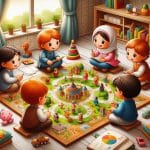In the world of game development, understanding player motivation is crucial to creating games that captivate and retain players. But why do people play games? What drives them to invest time and energy into virtual worlds? By exploring the psychology behind player motivation, game developers can design experiences that resonate with diverse audiences. This blog post will delve into different player motivations and provide insights on how to design games that cater to these motivations. Whether you’re a seasoned developer or a newcomer to the field, understanding these dynamics will enhance your ability to create engaging and successful games.
The Psychology of Player Motivation
What is Player Motivation?
Player motivation refers to the reasons why individuals engage in gaming activities. These motivations can vary widely, from seeking entertainment and relaxation to pursuing challenges and social interactions. Understanding these motivations helps developers create games that meet players’ needs and keep them coming back for more.
Why Do People Play Games?
People play games for various reasons, often driven by intrinsic and extrinsic motivations. Intrinsic motivation comes from within the player, such as the joy of solving a puzzle or the thrill of mastering a new skill. Extrinsic motivation involves external rewards, like earning points, badges, or recognition from peers. Here are some common motivations:
- Fun and Enjoyment: Many players seek games that are entertaining and enjoyable. They want to escape from reality, relax, and have fun.
- Challenge and Achievement: Some players are motivated by challenges and the sense of accomplishment that comes from overcoming difficult tasks. They enjoy games that test their skills and provide opportunities for growth.
- Social Interaction: Multiplayer games offer opportunities for socializing and building connections with others. Players may seek camaraderie, competition, or cooperation.
- Exploration and Discovery: Curiosity drives some players to explore virtual worlds and uncover hidden secrets. They enjoy the sense of adventure and discovery.
- Creativity and Expression: Games that allow players to express their creativity, such as building or designing, appeal to those who enjoy crafting and personalizing their experiences.
- Escapism and Relaxation: For some, games provide a way to unwind and escape from the stresses of everyday life. They seek immersive experiences that offer a temporary retreat from reality.

Types of Players and Their Motivations
Understanding different types of players and their motivations is essential for designing games that cater to diverse audiences. Here are some common player types based on their primary motivations:
1. Achievers
Motivation: Achievement and mastery
Achievers are driven by the desire to complete tasks, earn rewards, and master game mechanics. They enjoy games with clear goals, progress tracking, and achievements. To engage achievers, incorporate:
- Challenging Levels: Design levels that increase in difficulty and require skill to complete.
- Achievements and Trophies: Offer rewards for completing specific tasks or reaching milestones.
- Progress Tracking: Provide ways for players to track their progress and see their accomplishments.
2. Explorers
Motivation: Exploration and discovery
Explorers love to discover new areas, uncover secrets, and learn about the game world. They appreciate games with rich, detailed environments and hidden content. To appeal to explorers, include:
- Open Worlds: Create expansive environments with plenty of areas to explore.
- Hidden Secrets: Add hidden items, easter eggs, and lore for players to find.
- Detailed Environments: Design visually appealing and immersive worlds.
3. Socializers
Motivation: Social interaction and community
Socializers enjoy interacting with other players, forming friendships, and engaging in cooperative activities. They prefer games that offer social features and community-building elements. To attract socializers, incorporate:
- Multiplayer Modes: Include cooperative and competitive multiplayer options.
- Social Features: Add chat systems, friend lists, and guilds or clans.
- Community Events: Host in-game events that encourage player interaction and teamwork.
4. Killers
Motivation: Competition and dominance
Killers thrive on competition and the thrill of defeating others. They seek games that allow them to demonstrate their skills and dominate their opponents. To engage killers, design:
- Competitive Modes: Offer PvP (player vs. player) modes and leaderboards.
- Skill-Based Challenges: Include activities that require strategy and quick reflexes.
- Rewards for Success: Provide tangible rewards for winning competitions or achieving high rankings.
5. Creators
Motivation: Creativity and expression
Creators are motivated by the ability to build, design, and personalize their experiences. They enjoy games that offer creative freedom and customization options. To cater to creators, include:
- Building Tools: Provide tools for players to create and customize their own content.
- Customization Options: Offer a wide range of customization options for characters, environments, and items.
- Showcase Creations: Allow players to share their creations with others and receive feedback.
Designing Games for Different Motivations
To design games that appeal to various player motivations, it’s essential to incorporate elements that cater to each type of player. Here are some tips for designing games that resonate with different motivations:
1. Blending Fun and Challenge
Balance fun and challenge to engage both achievers and those seeking relaxation. Create levels that start easy and gradually increase in difficulty, providing a sense of progression and accomplishment.
2. Creating Immersive Worlds
Develop rich, detailed game worlds that encourage exploration and discovery. Use visuals, sound, and storytelling to immerse players in the game environment.
3. Enhancing Social Features
Integrate social features that facilitate communication and collaboration. Encourage community building through multiplayer modes, chat systems, and in-game events.
4. Offering Creative Freedom
Provide tools and options for players to express their creativity. Allow them to build, design, and customize their experiences, and give them opportunities to share their creations with others.
5. Rewarding Competitive Play
Design competitive modes that reward skill and strategy. Include leaderboards, rankings, and tangible rewards for players who excel in competitions.

Use Case Scenarios
Scenario 1: Multiplayer RPG for Diverse Motivations
Imagine a multiplayer RPG called “Realm of Legends” designed to cater to various player motivations. The game features:
- Achievement: Players can complete quests, earn achievements, and level up their characters.
- Exploration: A vast open world with hidden secrets, lore, and detailed environments.
- Social Interaction: Guilds, friend lists, and chat systems for socializers.
- Competition: PvP arenas and leaderboards for competitive players.
- Creativity: Tools for players to design their own gear and share their creations.
“Realm of Legends” provides a balanced experience that appeals to achievers, explorers, socializers, killers, and creators, ensuring that every player finds something they enjoy.
Scenario 2: Casual Puzzle Game for Relaxation and Fun
Consider a casual puzzle game called “Mystic Tiles” aimed at players seeking relaxation and fun. The game includes:
- Easy-to-Learn Mechanics: Simple, intuitive gameplay that is easy to pick up.
- Gradual Difficulty: Levels that start easy and become more challenging.
- Relaxing Aesthetics: Calming visuals and soothing music.
- Achievements: Rewards for completing levels and reaching milestones.
- Social Sharing: Options to share progress and achievements with friends.
“Mystic Tiles” provides a stress-free gaming experience that is both entertaining and rewarding, perfect for players looking to unwind.
Scenario 3: Creative Sandbox Game for Builders
Imagine a sandbox game called “Pixel Craft” designed for creators. The game offers:
- Building Tools: Comprehensive tools for players to build structures and design landscapes.
- Customization: Extensive options for character and item customization.
- Sharing Platform: An in-game platform for players to share their creations and view others’ work.
- Community Challenges: Regular building challenges with themes and rewards.
- Exploration: An open world for players to explore and find inspiration.
“Pixel Craft” provides a creative playground where builders can express their creativity, share their work, and engage with a like-minded community.
Conclusion
Understanding player motivation is essential for designing games that engage and retain players. By recognizing the different reasons why people play games, from seeking fun and relaxation to pursuing challenges and social interactions, developers can create experiences that resonate with diverse audiences. Whether catering to achievers, explorers, socializers, killers, or creators, incorporating elements that address various motivations will enhance the overall appeal and success of your games.
Player motivation in games is a fascinating and complex topic, but with the right insights



